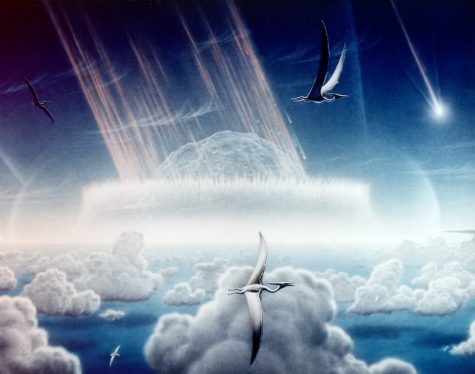Earth-Shattering Discoveries in Dinosaur Crater

Nearly 66 million years into the past, the Earth witnessed its single most catastrophic devastation that wiped out 90 percent of the existing species. The meteor which caused this calamity struck the Earth with such force that it left a 100 mile crater in the Yucatan Peninsula of Mexico, the Chicxulub crater. Recently, a group of geophysicists, led by Dr. Sean Gulick and Dr. Joanna Morgan, drilled 670 meters beneath the seafloor to retrieve core samples from the “peak rings” of the crater, a circular ridge that characterizes complex, large impact craters. In doing so, the team was able to understand what happened on the Earth’s surface during impact 66 million years ago with greater detail than ever before.
Prior to this recent discovery, scientists could not give a detailed answer as to why the dinosaurs went extinct and how the impact transformed the Earth. The crater was not discovered until the late 1970s, and the idea that this asteroid caused the dinosaur extinction was only proposed in 1980. Revelations from this most recent probe, however, have allowed the team of geophysicists to unravel the mystery that had obscured the explanation of what happened during this disastrous impact. Within the peak rings of this crater, the scientists were able to uncover the actual granite bedrock that formed right after the Chicxulub.
This team was the first group of scientists to uncover samples from the Chicxulub crater off land, and they travelled thirty kilometers off the shore of the Gulf of Mexico to find the optimal location. Additionally, the group was burdened with the task of drilling through sixty feet of water and nearly half a mile of limestone and other sediments. Thus, the team of scientists was very surprised when they suddenly found granite beneath all the other layers of rock. Dr. Gulick commented, “It was limestone, limestone, limestone. And then suddenly pink granite! It was exhilarating, it looks like your classic pink granite countertop.”
Right as the asteroid hit the Earth, granite bedrock, which is usually very deep in the Earth’s crust, acted like a fluid and rebounded into a mountain as tall as ten kilometers before collapsing and forming the peak ring. After this peak ring was created, debris and chunks of rock called breccia covered the ridge. Finally, immense tsunamis called megatsunamis carried waves of sediments that piled on top of the peak ring and breccia, which eventually formed layers of limestone over the course of millions of years.

The findings by this group of geophysicists could help scientists decide on a theory for how the Chicxulub crater collapsed. Before the publication of the groups’ findings on the journal Science on November 17th, many scientists argued that the peak rings of the Chixculub crater had formed from layers of rock and sediments in the upper part of the crust. However, the findings of Dr. Gulick and Dr. Morgan’s team seem to show that the peak rings were formed by hard rocks deep within the crust of the Earth. In addition to this, the discoveries also shed light on discrepancies in the K-Pg boundary, which is the transition from the Cretaceous period (the last age of the dinosaurs) and the Paleogene period (which began 66 million years ago). The start of the Paleogene period was originally defined by the appearance of the fossils of tiny shelled creatures called foraminifera, which Dr. Gulick and Dr. Morgan’s team found at a depth of 620 feet. However, the gap between the 670 feet (where they first encounter the granite rock layer) and 620 feet should also be included in the Paleogene period, because these rock layers formed after the impact of the asteroid 66 million years ago. For the sake of simplicity, however, Dr. Gulick established that scientists should name this fifty foot period of time an ‘event layer.’
Despite their incredible efforts and findings, the group of scientists are not yet finished with their research. Having reached the peak rings of the crater, the scientists hope to further analyze deeper rock layers and veins of minerals in the peak rings to find further details about the impact of the meteor. If their expedition proves successful, these scientists will be major figures who discovered secrets and mysteries of the dinosaur impact that has haunted the scientific body for decades.





